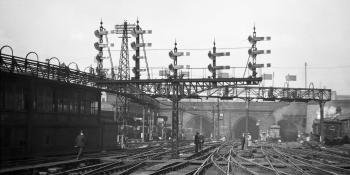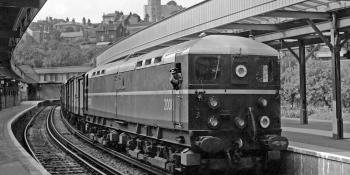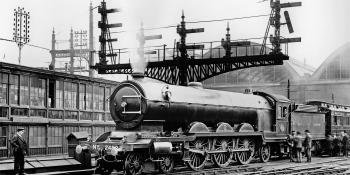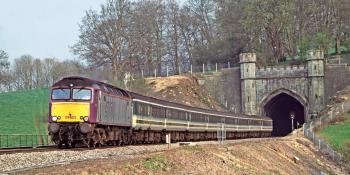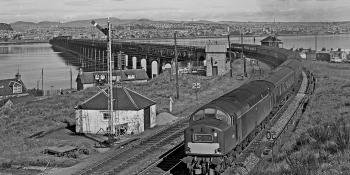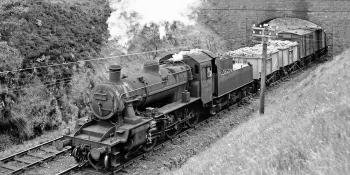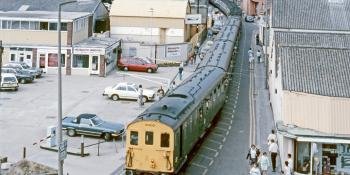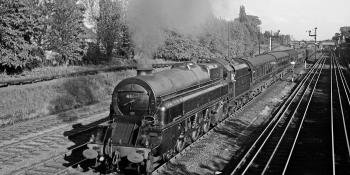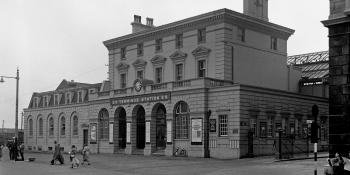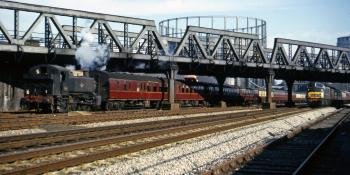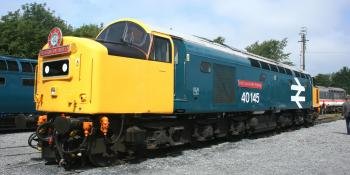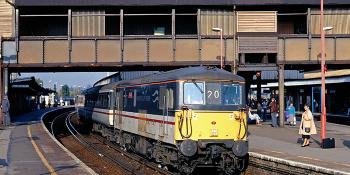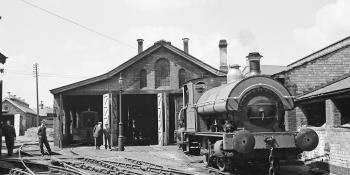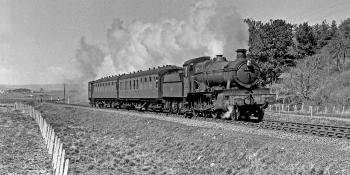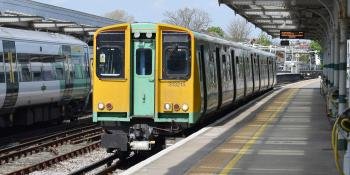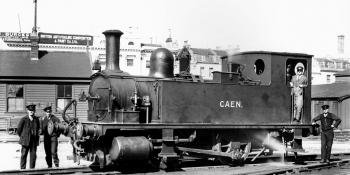RAILWAY HISTORY
Join us and delve into the archives to discover the stories of locomotive classes large and small, learn how the railway worked, and why it was built in this amalgamation of the popular Reality Check and Railway Realism sections from Hornby Magazine.
RAILWAY REALISM: BR’s visionary XP64 coaches
British Railways sought a radical reinvention of long-distance trains in the 1960s – and the famous XP64 coaches set a template that still resonates today, as EVAN GREEN-HUGHES explains.
Brush Type 2 Variants
The distinctive Class 31s had a panoply of variants which cry out to be modelled - and some very obvious external differences. EVAN GREEN-HUGHES investigates.
RAILWAY REALISM: Great Western Electrification
One of the most significant upgrades to the country’s railway in recent years has been electrification of the Great Western Main line from Paddington to South Wales and the West – but it had huge troubles, as EVAN GREEN-HUGHES describes.
Class 50s go West
The distinctive Class 50s were perhaps at their best after being reallocated to the Western Region in the 1970s, as EVAN GREEN-HUGHES describes.
Railway Signalling
Signalling is vital for the safe operation of the railway – and if correctly modelled it can help emphasise the period, region and realism of a model railway, as EVAN GREEN-HUGHES describes.
REALITY CHECK: Class 25 Variety
The numerous Class 25s have a rather confusing history, as within the 327 examples built there have been numerous sub-classes and individual variations, as EVAN GREEN-HUGHES explains.
Last knockings of the Class 101s
Although it is now 20 years since the last Class 101 DMUs were withdrawn, these units outlived many of their counterparts by a handsome margin. EVAN GREEN-HUGHES looks back at these successful trains and relates the story of their extended final years.
Diesel Days at Westbury
A railway crossroads, Westbury has long been an important rail hub and remains a major centre for a varied selection of passenger and aggregate traffic, as EVAN GREEN-HUGHES describes.
THE HIGHLAND MAIN LINE
Stretching across 118 spectacular miles, the Highland Main Line is a vital artery linking the Far North for more than 150 years, as EVAN GREEN-HUGHES explains.
GWR Steam Railmotor
Railways have always faced the problem of how to work their most lightly used routes cheaply. One solution that found much favour in Victorian times was the steam railmotor, as EVAN GREEN-HUGHES explains.
The Dawlish Sea Wall
Few railway locations are as recognisable as the famous sea wall at Dawlish in Devon, where for a hundred years trains have done battle with the elements, sometimes in spectacular style. EVAN GREEN-HUGHES explains why this railway was built and what the future may hold for it.
REALITY CHECK: Southern Railway CC1 ‘Booster’
To power goods trains on its electric network, the Southern Railway built one of the most innovative and unusual locomotive designs ever to appear on our railways. EVAN GREEN-HUGHES looks into the history of the Class 70, otherwise known as the ‘Booster’.
What Next? LNER
Continuing his survey of the ‘Big Four’ railways, Trevor Jones picks out some ‘missing links’ of the LNER and constituents that could be modelled in ‘OO’ gauge.
Speedlink freight operations
The 1960s are usually best remembered for Beeching’s railway closures but this period also saw a number of innovations, not least the rapid Speedlink freights with their distinctive long-wheelbase wagons, as EVAN GREEN-HUGHES remembers.
Class 57s
While remanufacture of existing locomotives is common practice in other countries it is quite rare in the UK. The Class 57, however, is an exception, having been rebuilt from the Class 47 two decades ago. EVAN GREEN-HUGHES takes a look at this successful conversion and its subsequent service history.
Iron bridges on the ‘iron road’
Although greatly favoured by early railway builders, the deficiencies of cast iron as a material for building railway bridges meant that its period of predominance was relatively short. EVAN GREEN-HUGHES looks at the history of this material and finds out what there is still left to see.
REALITY CHECK: The BR Standard '2MT' 2-6-0s
The old saying of ‘if it isn’t broke, don’t fix it’ is often used in railway circles and this saying was never more true than in the design of the ‘2MT’ 2-6-0s which, despite being a BR Standard design, were near identical copies of an earlier type, as EVAN GREEN-HUGHES explains.
Southern Region first-generation DEMUs
Forever identified with the Southern Region, British Railways’ first diesel-electric multiple units, affectionately known as ‘Thumpers’, were developed quickly due to a unique set of circumstances, yet proved very successful, as EVAN GREEN-HUGHES explains.
Stanier's 'Turbomotive' design and development
Throughout the history of the railways experiments have aimed at improving the efficiency of the steam locomotive. One of these was Stanier’s ‘Turbomotive’, a bold initiative that used turbines instead of cylinders and valve gear for propulsion. EVAN GREEN-HUGHES looks at the history of this unusual locomotive.
Reality Check: Terminus Operation
Throughout the railway age the terminus has been an important part of the operational scene, and one that has brought with it special requirements, as EVAN GREEN-HUGHES describes.
GWR ‘15XX’ 0-6-0PTs
Pannier tanks were synonymous with the Great Western Railway and their last evolution broke with many cherished traditions. EVAN GREEN-HUGHES charts the history of the distinctive and powerful ‘15XX’ class.
40145 - the large logo Whistler
One of the most recognisable locomotives on the preservation scene is D345, otherwise known as 40145, a machine that gained fame when it was, for a time, painted in BR large logo blue, a livery it never carried in front-line service. EVAN GREEN-HUGHES tells its story.
BR’s Class 73 electro-diesel
Despite its considerable third-rail electrified system the Southern Region had a needed a unique and special type of locomotive. EVAN GREEN-HUGHES looks back at the history of the Class 73.
Private and Industrial Railways
Thanks to the recent introduction of several new models of industrial prototypes, interest in non-main line railways has boomed over the last couple of years. EVAN GREEN-HUGHES examines the world of private railways and explains how they can inspire future modelling projects.
BR's brilliant Class 58 Co-Co heavy freight diesels
One of the most recognisable British-built diesel locomotives is the Class 58 - a successful design which never quite achieved its potential, as EVAN GREEN-HUGHES explains.
Collett GWR ‘Manors’ on the Cambrian
Designed as a lightweight equivalent of the ‘Hall’ 4-6-0s, the Great Western’s ‘Manors’ did their best work on the Cambrian lines of mid and north Wales. EVAN GREEN-HUGHES explains why these versatile locomotives were so successful.
BR’s North British 10800
Although many people think that BR’s Modernisation Plan was the start of the diesel era, there had been several attempts to introduce alternative traction prior to that, with one of the least successful being 10800, which was, as EVAN GREEN-HUGHES relates, ordered before nationalisation.
British Rail ‘PEP’ Electric Multiple Unit story
Rarely modelled, but part of the railway scene now for almost 50 years, the British Rail ‘PEP’ family of EMUs is now reaching the end of its service life. EVAN GREEN-HUGHES takes a look at the interesting history of this group of influential but often overlooked trains.
LSWR ‘B4’ 0-4-0T class history
Although primarily known for their work in Southampton Docks, the Adams ‘B4s’ actually had a wide sphere of operation, both on the main line and later on industrial railway complexes, as EVAN GREEN-HUGHES describes.




